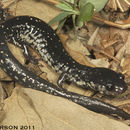Description
provided by AmphibiaWeb articles
Very attenuated Plethodon with short limbs. 16 costal grooves (counting a Y-shaped groove in the groin as two grooves). 4-6 costal folds between adpressed limbs. Peritoneum is not distinctively pigmented. 40 premaxillary/maxillary teeth. Palatine teeth in large median patch, 12 teeth wide and 18 teeth long. Vomerine teeth in two well-separated arc-shaped rows with 8-10 teeth in each row. As with all Plethodon, this species has four digits on the manus and five on the pes, a cylindrical tail without any basal constriction, and a tongue attached in the front (Lazell 1998). In preservative, the specimens are dark blackish-brown without any noticeable pattern, and the peritoneum lacks any distinctive pigmentation (Lazell 1998).The holotype and paratype were collected by Jackson Harold Ainsworth as Plethodon glutinosus in 1964, and described as a new species, Plethodon ainsworthi, by Lazell (1998).
Lazell, J. (1998). ''New salamander of the genus Plethodon from Mississippi.'' Copeia, 1998, 967-970.
Distribution and Habitat
provided by AmphibiaWeb articles
Collected two miles south of Bay Springs, Jasper County, Mississippi, possibly on Ainsworth family property (two miles south of Bay Springs on old highway 15), in springhead litter (Lazell 1998). The area was a mixed mesic woodland with springheads and seepage when resurveyed in 1991, draining into Tallahoma Creek (Lazell 1998).
Life History, Abundance, Activity, and Special Behaviors
provided by AmphibiaWeb articles
This species is believed to be extinct. The only two specimens were collected on June 12, 1964, and despite recent survey work, no more have been found. It is believed to have reproduced by direct development of terrestrially laid eggs (Stuart et al. 2008).
Life History, Abundance, Activity, and Special Behaviors
provided by AmphibiaWeb articles
Habitat loss through deforestation is thought to have been the major factor leading to the extinction of this species (Stuart et al. 2008). Perhaps specializd habitat has been lost. Other species of salamanders were abundant at the site in 1991 (Desmognatheus auriculatus, Eurycea bislineata, Pseudotriton ruber vioscai in the moister areas, and Plethodon mississippi in the drier areas), but the presumed forest locality was surrounded by poor-quality habitat. The area had been recently clearcut to within 100 m north of the springheads and open pasture was present to the east of the springheads (Lazell 1998). About two hectares of intact forest were present in 1991 (Lazell 1998).
Mississippi slimy salamander: Brief Summary
provided by wikipedia EN
The Mississippi slimy salamander (Plethodon mississippi) is a species of terrestrial plethodontid salamander found throughout most of the U.S. state of Mississippi, western Alabama, western Tennessee, far western Kentucky, and eastern Louisiana. The Mississippi slimy salamander is part of the larger slimy salamander (P. glutinosus) complex.
- license
- cc-by-sa-3.0
- copyright
- Wikipedia authors and editors

